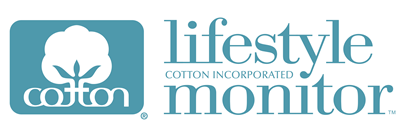
Perhaps because of their fashion forwardness and desire to
find the perfect, trendy ensemble, Hispanics spend an
average of 22 more minutes shopping in-store than non-
Hispanics. This is an opportunity for brands and retailers to
take advantage of a captive audience and the additional
time
and money they could potentially contribute to a store’s bottom
line.
Although both Hispanic and non-Hispanic shoppers are
most likely to get wardrobe inspiration from what they already
own and like, Hispanics are more likely to be motivated
by fashion magazines, television shows, commercials, and
celebrities. Targeted marketing through these channels,
such as gaining a celebrity endorsement, partnering with a
magazine that has a substantial Hispanic readership, or
collaborating with Hispanic-centric television shows, could
be effective ways to stimulate apparel purchases among this
fashionable demographic.
As the largest minority population in the United States,
Hispanics have the buying power to positively impact the
futures of brands and retailers. They currently spend an
additional $370 annually
2
on apparel and services compared to
non-Hispanic demographics, and are projected to total 31%
of the U.S. population by 2060
1
.
If brands and retailers are still considering whether or
not
to target this burgeoning market segment, they should
consider the fact that current estimates list Hispanic apparel
and services spending at more than $30 billion
2
. Winning
the loyalty of Hispanic consumers could secure a confident
future for brands and retailers willing to tailor their services to
meet the demands of this growing demographic.
FASHION FORWARD
Hispanic consumers have distinguished themselves as a
unique customer segment in part through their strong
tendency toward being fashion forward. Hispanics are more
likely than non-Hispanics to adopt new fashions earlier (43% vs.
34%) as well as buy these fashions at the beginning of the
season (27% vs. 19%). This suggests that many Hispanics
are willing to pay a premium for newness. This fashion
forwardness can be critical for brands and retailers as they
are eager to move merchandise off the shelves to make room
for new, full cost apparel.
KEY INSIGHTS
• Promote fashion-forward trends to capture the attention and
dollars of this growing demographic.
• Cater to the social aspects of shopping and provide additional
product education to increase consumer loyalty.
• Deliver performance features and outfits customized for each
sport in cotton fabrics to build sales.
How can brands and retailers leverage the additional
22 minutes Hispanic consumers spend in store?
FASHION INSPIRATION
fashion
magazines
TV
shows
commercials
& ads
celebrities
25%
21% 21%
13%
18%
17%
18%
10%
Hispanic
non-Hispanic
INSIGHTS
COTTON INCORPORATED
SUPPLY CHAIN
SECURING THE HISPANIC CONSUMER

SHOPPING HABITS
Contrary to non-Hispanic consumer segments, Hispanic
shoppers are more likely to view shopping as a fun, social
activity (67% vs. 54%). In fact, they are more likely than
non-
Hispanics to say they love or enjoy shopping which could be
another contributing factor to why they spend more time in-store
(63% vs. 51%). Creating social spaces where customers can
linger – such as areas for snacks, drinks, or comfortable seating
– and fostering authentic conversations among staff and
customers could generate longer shopping times. This potentially
translates into more sales and a more loyal customer base.
Another substantial way to encourage loyalty among this
budding consumer demographic is to provide increased
apparel product education. This could yield noticeable
results as Hispanic consumers are 40% more likely than non-
Hispanics to be loyal to brands providing product
education (56% vs. 40%). Even basic education regarding fiber
content and garment care could be beneficial. When it comes
to choosing which fibers to wear, they consider cotton a
favorite (72%) and are willing to pay more than non-Hispanics
for cotton items such as 7% more for a good-fitting pair of denim
jeans.
ATHLETIC APPAREL
As performance features become more popular and
the
athleisure trend continues to gain traction, it is critical to note
how
Hispanic consumers relate to these and other athletic apparel
trends. Hispanic consumers participate in high-intensity
workouts and are more likely than non-Hispanics to participate
in dance or Zumba (18% vs. 11%) and running or jogging (25%
vs. 18%). Many of these and other high-
intensity activities demand performance features as well as
custom apparel, outfits, and accessories. This could explain why
Hispanics are 50% more likely than non-Hispanics to buy a
new outfit when taking up a new athletic activity (21% vs. 14%).
Brands and retailers can capitalize on athletic trends
while also taking advantage of the fact that Hispanic
customers are willing to pay a premium for the perfect
athletic outfit ($87). This is a 37% spending increase over
non-
Hispanic demographics. In fact, they are willing to pay even
more for performance features in their favorite fiber – cotton.
Performance features Hispanics are willing to splurge on include
cotton products that prevent odor, regulate temperature,
shape and smooth, and don’t show sweat. Providing these
fabric innovations in cotton will help brands and retailers secure
the spending power of this growing demographic.
Hispanics are willing to pay $42 for a good-fitting
pair of denim jeans.
Hispanics are 50% more likely to buy a new outfit for
a new athletic activity & pay 37% more compared to
non-Hispanics.
REGULATE TEMP.
SHAPE & SMOOTH
PREVENT ODOR
% WILLING TO PAY MORE FOR COTTON
PERFORMANCE FEATURES THAT...
.
65%
56%
54%
59%
71%
64%
64%
66%
HISPANICS
NON-
HISPANICS
DON’T SHOW SWEAT
SECURING THE HISPANIC CONSUMER
About the Research
Cotton Incorporated
Lifestyle Monitor
TM
survey, an ongoing survey among 6,000 U.S. consumers annually; Cotton Incorporated 2014 Sports Apparel Study,
a survey of over 1,500 U.S. respondents. External data sources: Pew Research Center
1
, U.S. Bureau of Labor Statistics
2









